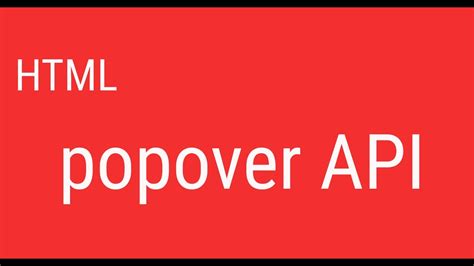The Popover API has opened up a new realm of possibilities for web developers, streamlining the process of creating popovers and tooltips. By providing a standard, consistent, and versatile mechanism for displaying popover content, this API has simplified complex UI implementations. Developers no longer need to rely on third-party libraries or custom solutions to achieve popover functionality. Using the native Popover API not only enhances code readability but also ensures better performance and compatibility across different browsers.
User comments shed light on various aspects of the Popover API, including its impact on accessibility. While some express concerns about the lack of a specific attribute like `role=’popover’`, others highlight the advantages of the API in managing modal states effectively and improving user interaction. The seamless integration of popovers into the DOM without heavy reliance on JavaScript is touted as a significant benefit, enhancing the overall accessibility and user experience.
Browser support is a crucial factor influencing the adoption of new web technologies. Comments reveal a mixed sentiment regarding the pace of implementation across different browsers. While some browsers like Firefox have already begun integrating anchor positioning, others are still catching up. The compatibility and availability of native features like the Popover API play a vital role in shaping the future of web development, enabling developers to leverage advanced UI components without external dependencies.
One notable advantage of the Popover API is its potential to reduce reliance on third-party dependencies and streamline the development process. Developers appreciate the semantic clarity and simplicity offered by the API, making it an appealing choice for creating interactive elements like popups and tooltips. By offering a standardized solution for common UI patterns, the Popover API empowers developers to focus on enhancing user experiences rather than dealing with intricate implementation details.
The discourse surrounding the security implications of the Popover API underscores the importance of balancing convenience with potential risks. While the API introduces new possibilities for user interactions, concerns about abuse and phishing attempts remain valid. Safeguarding user privacy and preventing malicious usage of popovers are critical considerations that must be addressed through robust design practices and security measures. By staying vigilant and implementing best practices, developers can harness the benefits of the Popover API while mitigating security threats.
As the web development landscape evolves, the adoption of native features like the Popover API signals a shift towards more efficient and accessible UI design. Integrating CSS anchor positioning with the Popover API promises to revolutionize the way developers create custom tooltips, context menus, and interactive overlays. By combining the power of native browser capabilities with modern CSS techniques, developers can craft engaging user interfaces that prioritize performance, usability, and design consistency.
In conclusion, the Popover API represents a significant advancement in web development, offering a standardized approach to implementing popovers and tooltips. User feedback highlights the diverse perspectives on accessibility, browser support, and the overall utility of the API in different development scenarios. By embracing native solutions like the Popover API, developers can enhance the user experience, streamline code maintenance, and adapt to evolving web standards with confidence.


Leave a Reply